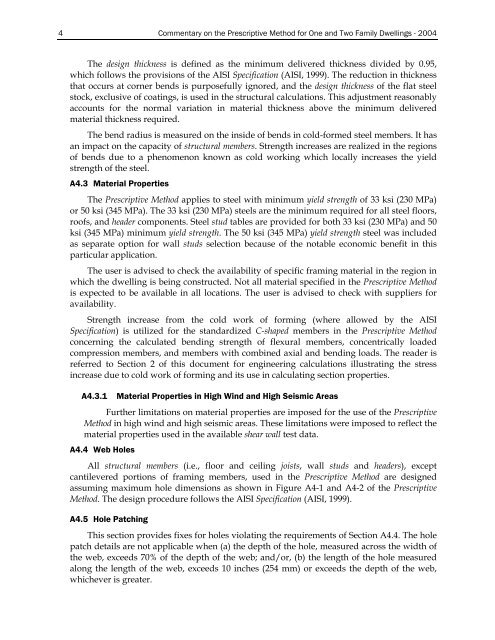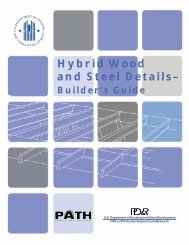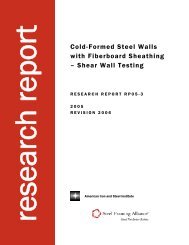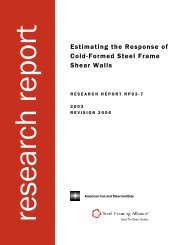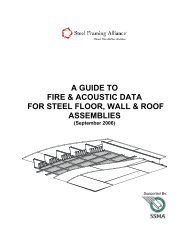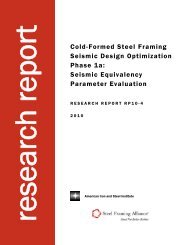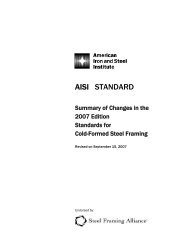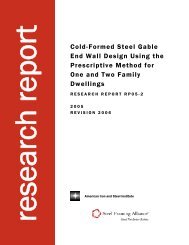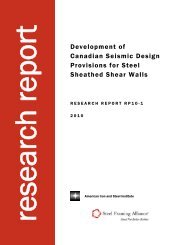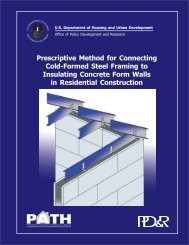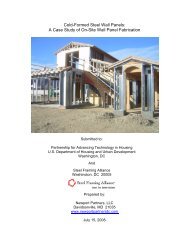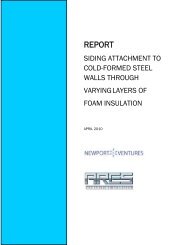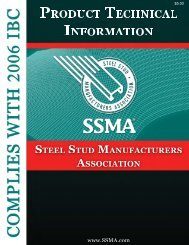SPECIFICATION FOR THE DESIGN OF - Transcon Steel
SPECIFICATION FOR THE DESIGN OF - Transcon Steel
SPECIFICATION FOR THE DESIGN OF - Transcon Steel
You also want an ePaper? Increase the reach of your titles
YUMPU automatically turns print PDFs into web optimized ePapers that Google loves.
4 Commentary on the Prescriptive Method for One and Two Family Dwellings - 2004<br />
The design thickness is defined as the minimum delivered thickness divided by 0.95,<br />
which follows the provisions of the AISI Specification (AISI, 1999). The reduction in thickness<br />
that occurs at corner bends is purposefully ignored, and the design thickness of the flat steel<br />
stock, exclusive of coatings, is used in the structural calculations. This adjustment reasonably<br />
accounts for the normal variation in material thickness above the minimum delivered<br />
material thickness required.<br />
The bend radius is measured on the inside of bends in cold-formed steel members. It has<br />
an impact on the capacity of structural members. Strength increases are realized in the regions<br />
of bends due to a phenomenon known as cold working which locally increases the yield<br />
strength of the steel.<br />
A4.3 Material Properties<br />
The Prescriptive Method applies to steel with minimum yield strength of 33 ksi (230 MPa)<br />
or 50 ksi (345 MPa). The 33 ksi (230 MPa) steels are the minimum required for all steel floors,<br />
roofs, and header components. <strong>Steel</strong> stud tables are provided for both 33 ksi (230 MPa) and 50<br />
ksi (345 MPa) minimum yield strength. The 50 ksi (345 MPa) yield strength steel was included<br />
as separate option for wall studs selection because of the notable economic benefit in this<br />
particular application.<br />
The user is advised to check the availability of specific framing material in the region in<br />
which the dwelling is being constructed. Not all material specified in the Prescriptive Method<br />
is expected to be available in all locations. The user is advised to check with suppliers for<br />
availability.<br />
Strength increase from the cold work of forming (where allowed by the AISI<br />
Specification) is utilized for the standardized C-shaped members in the Prescriptive Method<br />
concerning the calculated bending strength of flexural members, concentrically loaded<br />
compression members, and members with combined axial and bending loads. The reader is<br />
referred to Section 2 of this document for engineering calculations illustrating the stress<br />
increase due to cold work of forming and its use in calculating section properties.<br />
A4.3.1<br />
Material Properties in High Wind and High Seismic Areas<br />
Further limitations on material properties are imposed for the use of the Prescriptive<br />
Method in high wind and high seismic areas. These limitations were imposed to reflect the<br />
material properties used in the available shear wall test data.<br />
A4.4 Web Holes<br />
All structural members (i.e., floor and ceiling joists, wall studs and headers), except<br />
cantilevered portions of framing members, used in the Prescriptive Method are designed<br />
assuming maximum hole dimensions as shown in Figure A4-1 and A4-2 of the Prescriptive<br />
Method. The design procedure follows the AISI Specification (AISI, 1999).<br />
A4.5 Hole Patching<br />
This section provides fixes for holes violating the requirements of Section A4.4. The hole<br />
patch details are not applicable when (a) the depth of the hole, measured across the width of<br />
the web, exceeds 70% of the depth of the web; and/or, (b) the length of the hole measured<br />
along the length of the web, exceeds 10 inches (254 mm) or exceeds the depth of the web,<br />
whichever is greater.


